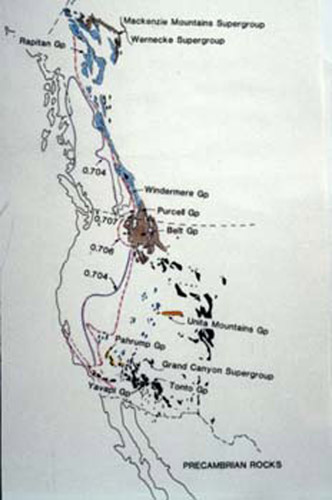lec2photo5.jpg
This map shows the actual outcrop distribution of Precambrian rocks in the Cordilleran region. This way you can see where the data comes from that we used to make the previous slide. In the end, few Precambrian rocks are exposed at the surface. The ones we are going to focus on are the blue ones next to the western edge of Precambrian rocks. These rock are some of the first sediments that were deposited along the western edge of the continent following rifting. They are 600-650 m.y. old and are not continuously outcropping along all of western NA, but can be interpreted to be the first sediments deposited near the passive margin. We will discuss these more with some slides to come. In the north here you can see a huge outcrop of older rocks, the Belt Group. They are 1.5 by to <1 b.y. old. The Belt rocks are still a big puzzle because (1) the western half are heavily metamorphosed and difficult to interpret and (2) they are also a super-thick pile of sediment, up to 15 kilometers! How is this possible? We know that the only way that this was possible was that the crust was extremely thin so that the sediments could be deposited. The Belt group could have been deposited in a weak thin part of the crust that was associated with the rifting along the western edge of NA before the passive margin development at a later (~600-680 m.y.) time. Still, the Belt Group remains a big mystery. Image courtesy of Professor Burchfiel.










